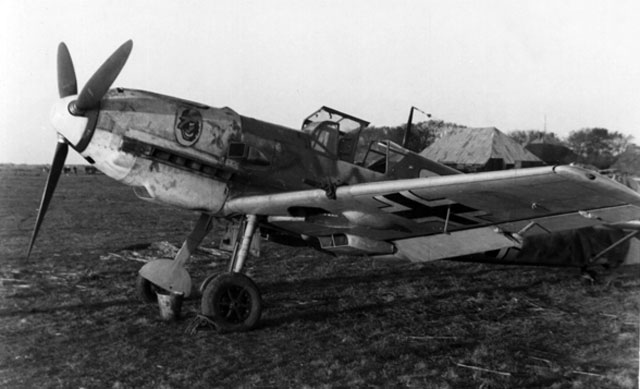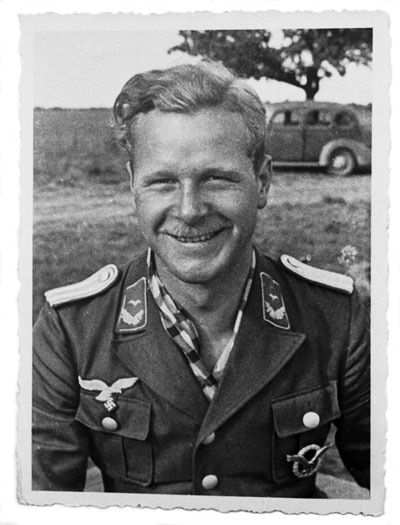
Air Power Editons has kindly supplied the following text extract and images from the first in their "Ace Profiles - The Men and Their Aircraft" series, "Hans Ekkehard Bob" by noted aviation historian Christer Bergstrom. This book may be purchased online exclusively through The Aviation Bookshop for GBP £18.99:
From Ace Profiles No. 1: Hans-Ekkehard Bob

On 17 April 1943, the commanders of the US Eighth Air Force decided to despatch to Germany the largest raid by then attempted, with the Focke-Wulf factory in Bremen as the target.
At the East Anglian airbase of Bassingbourn, south-west of Cambridge, Col. Stanley T. Wray’s 91st Bombardment Group assigned a record 32 Boeing B-17Fs for the mission. All of these took off in rapid succession between 0956 hours and 1008 hours. Hazy skies reduced visibility to less than one kilometre but this did not prevent the crews from rendezvousing with 306th Bombardment Group. These two B-17 Groups formed the leading 101st Provisional Combat Wing followed by the 303rd and 305th Bombardment Groups in the 102nd PBCW. Over one hundred heavy bombers flew across the North Sea.
In the 91st Bombardment Group, which flew at the head of the entire formation, five olive-drab B-17Fs of the 401st Squadron formed the Low Squadron. One of these was aircraft No. 459, Serial No. 42-24459, baptized ‘Hellsapoppin’ – with the crew of 1/Lt John W. Wilson: 1/Lts Robert Barton, Arthur A. Bushnell and Harold Romm, Technical Sergeants Howard A. Earney and Norman L. Thompson, and Staff Sergeants Robert H. Ade, Gilbert F. Andrews, Walter Bohaczyk, and Clifford E. Cadle.
There were small cloud patches between 1,800 and 6,000 metres altitude, but the cloud cover never exceeded 5/10 density.
By intercepting the intense radio communication at the American bomber bases in East Anglia, the Germans were able to ascertain in good time that a large raid force was being assemled. At Oldenburg, the pilots of III./JG 54 were placed at ‘cockpit readiness’ before noon.
Some of the American aircraft encountered problems during the approach flight and had to turn back. A total of 109 aircraft remained on course – 29 of those from the 91st Bombardment Group – as they passed over the East Frisian Islands at an average 7,900 metres altitude. They encountered some Flak, but none of the bombers from the 91st Group received any serious hits.
At Oldenburg, the pilots who sat strapped in their Bf 109s saw a red flare shoot into the air shortly before 1230 hours – the sign to scramble. Led by the Gruppenkommandeur, Major Reinhard Seiler, the Bf 109s raced across the runway, lifted into the air and formed up into Staffeln. With Hptm. Bob in the lead, the ‘Teufelstaffel’ positioned itself just behind Seiler’s Stabsschwarm. The Bf 109s climbed as fast as possible to reach an altitude of almost 9,100 metres, and were vectored towards the north-west by ground control. The Messerschmitt pilots had barely reached their combat altitude when they saw the American bombers – over one hundred B-17s – heading towards the south-east.
1/Lt John W. Wilson in ‘Hellsapoppin’ and the other American bomber crews saw the German fighters appear as small dots between the clouds in the sky, as they passed high above the ground haze which covered the flat landscape of northern Germany. But at first no attacks were made.
 Bob led his pilots past the bombers on a parallel course on their left-hand side, with the purpose of carrying out a frontal attack. This method had proved to give the best results, which had been established by RAF fighter pilots during the Battle of Britain.This was because through a rapid frontal attack, the vulnerable fighters would be exposed for only a short period of time to the forward defensive armament of the bombers and a hit in the flight deck could send a bomber out of formation. Also the B-17s lacked effective armour against fire from around the 12 o’clock position. Bob led his pilots past the bombers on a parallel course on their left-hand side, with the purpose of carrying out a frontal attack. This method had proved to give the best results, which had been established by RAF fighter pilots during the Battle of Britain.This was because through a rapid frontal attack, the vulnerable fighters would be exposed for only a short period of time to the forward defensive armament of the bombers and a hit in the flight deck could send a bomber out of formation. Also the B-17s lacked effective armour against fire from around the 12 o’clock position.
While his Bf 109s moved further forward and started overhauling the bombers, striving for the best point to turn and launch the attack, Bob could see other formations of German fighters – both Bf 109s and Fw 190s – attempting in similar ways to reach suitable positions for an attack. The gunners in ‘Hellsapoppin’, flying on the right wing in the Low Squadron’s second element, kept a nervous but watchful eye on the fighters.
Just as Bob’s Bf 109s had gained enough lead to turn and perform the attack, the cluster of bomber boxes turned to port – placing the ‘Teufelstaffel’s’ Bf 109s on their right-hand side. Leading a whole Staffel in this way was unwieldy, and definitely not what Bob was used to from his years in the East. He adjusted the flight direction in order to again reach a position ahead of the Americans, but the mass of bombers continued turning left, leaving Bob’s Messerschmitts racing on its right-hand flank.
The bombers had reached their Initial Point, Wildeshausen, south-west of Bremen, and were heading straight for their target. As Bob followed them towards Bremen, where Flak bursts mottled the sky with black, he could see the first Bf 109s conduct their attacks. Major Seiler, who had been placed in a more suitable position before the bombers started veering to the left, blew the first B-17 - from the 306th Bombardment Group – out of the sky.
The bombers flew in over Bremen, and five hundred and thirty-one 1,000lb General Purpose bombs rained down from the formation. The Boeings then went into a 270-degree right turn over the target for the flight home.
Defying the heavy Flak barrage, Bob’s Staffel and several other German fighters pursued the bombers over Bremen. Inside the bombers, the young Americans cried out directions of the incoming Messerschmitts and Focke-Wulfs. Lt. Heinz Knoke, the Staffelkapitän of Bf 109-equipped 5./JG 11 attempted a trick he had previously performed with success – he dropped a bomb from above at the American formation. This time without effect.
The terrified men in ‘Hellsapoppin’ saw how the leading aircraft of their Low Squadron’s first element, Capt. Oscar O’Neill’s ‘Invasion 2nd’, was shot ablaze by three fighters which made a lightning strike from 12 o’clock high. The mighty bomber, engulfed in flames, turned and twisted slowly while descending. Miraculously, all the crew managed to bale out – into captivity.
By that time, the right turn performed by the bombers had placed Bob just ahead of them. He did not want to lose another opportunity, so he immediately turned back and opened a frontal attack against the leading bombers. With an approach speed of over 800 k/ph, the initial distance of 450-540 metres was covered in a matter of seconds. In this very brief space of time, Bob saw the gigantic bomber grow until it filled the whole windscreen in front of him; he fired all his guns and saw excellent results from 20mm hits in the canopy, the nose and the left engines.
In ‘Hellsapoppin’s’ nose section, the nose window plexiglass was damaged and a one-and-a-half-foot hole appeared; the bombardier, 1/Lt Harold Romm, was hit in the left leg. The pilot, 1/Lt. John Wilson, was wounded in the head; his co-pilot, 1/Lt. Arthur Bushnell was wounded by shrapnel in the right eye, left arm, right hand, and both legs. In the radio compartment, leaking oxygen from broken oxygen lines caught fire; the port wing was also burning.
At the last moment, Bob pushed the stick forward and attempted to dive his Bf 109 to the left, and beneath the crippled bomber. But his manoeuvre was carried out a fraction of a second too late.
Bob flashed beneath the bomber and, just as he did, he heard a crash and felt a terrible jolt. Looking back, he saw that his Bf 109 had lost its whole tail section, and he also saw that a part of the bomber’s starboard wing was missing.
Technical Sergeant Norman Thompson, the flight engineer in ‘Hellsapoppin’, felt a very hard jerk under the left side of the aircraft, close in to the fuselage, three or four minutes after ‘Bombs Gone’. The impact was so powerful that it flung him through the interior of the bomber. He believed that the plane had been hit by heavy Flak.
Bob’s tailless Messerschmitt went into a violent spin…
Read more in Ace Profiles No. 1: Hans-Ekkehard Bob
www.airpowereditions.com
AirPower Editions – Cutting Edge Research
Available exclusively online from The Aviation Bookshop for GBP £18.99
Text and Images Copyright © 2008 by Air Power Editions
This Page Created on 11 March, 2008
Last updated 11 March, 2008
Back to HyperScale Main Page
Back to Reviews Page
|
Home
| What's New | Features | Gallery | Reviews | Reference | Forum | Search